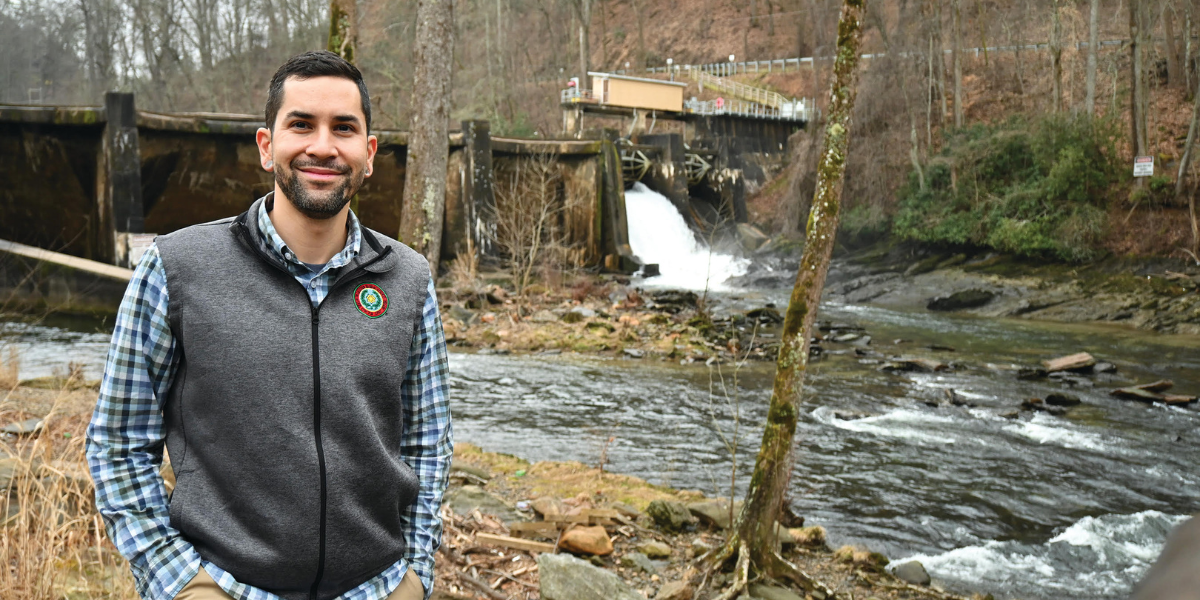Let The River Run: The Ela Dam and Plans Move Forward to Reconnect A Historic Cherokee River

On October 3, 2021, a slug of sediment was released from Ela Dam, which impounds the Oconaluftee River in western North Carolina, smothering the streambed downstream.
This action unleashed a wave of momentum for removing the nearly 100- year-old dam and reconnecting 549 miles of streams in the Oconaluftee River watershed with the Tuckasegee River. Ela Dam, also known as Bryson Dam, is on the Oconaluftee River in Swain County, North Carolina, just over half a mile upstream from its confluence with the Tuckasegee River. Nearly all land upstream of the dam is either part of the Eastern Band of Cherokee Indians’ (EBCI) Qualla Boundary or Great Smoky Mountains National Park. There isn’t another dam in the watershed—Ela Dam is the only thing keeping the Oconaluftee River from being a completely free-flowing river.
A coalition convened by Joey Owle, secretary of agriculture for the Eastern Band of Cherokee Indians, is now working to reconnect the watershed by removing the Ela Dam.
“The Cherokee have always had a strong relationship with water, and the Ela Dam has disconnected us for nearly a century,” says Owle. “With a team of exceptional partners, this is an opportunity of a lifetime for our people.”
The coalition includes the dam owner, Northbrook Carolina Hydro II, with the U.S. Fish and Wildlife Service, American Rivers, Mainspring Conservation Trust, North Carolina Wildlife Resources Com – mission, U.S. Army Corps of Engineers, the North Carolina Wildlife Federation, and others. All of the groups have identified this as a once-in-a-lifetime opportunity to eliminate the only physical barrier preventing the Oconaluftee River from flowing freely—physically and symbolically reconnecting the Cherokee with ancestral waters downstream.
Dam removal could also increase potential for development of river-based recreation, including increased fishing access, increased tubing and paddling, and snorkeling. Importantly, dam removal will restore habitat for the sicklefin redhorse, a threatened fish endemic to only a few rivers in the Southern Appalachians that was once an important element of the Cherokee diet. The dam has blocked the migration route for the fish, disrupting centuries of cultural connection by effectively eliminating it from tribal lands and contributing to imperiling population declines for the species. Dam removal also stands to benefit other species, including Eastern Hellbender and Appalachian elktoe (a federal endangered mussel).
Initial studies assessing the potential for dam removal have been made possible largely by funding from the State of North Carolina through the N.C. Wildlife Resources Commission. Now the coalition is working to pursue money made available through the recent federal Bipartisan Infrastructure Law. Adequate funding for dam removal would reconnect this long- bisected watershed, improve habitat for rare species, and help strengthen the connection between the Eastern Band of Cherokee Indians and their ancestral homelands. The coalition expects to know whether the project is selected for federal funding by summer 2023.
In the meantime, the coalition continues the necessary preparations to secure removal of the dam — setting an example of how diverse stakeholders can work together towards a common objective.


